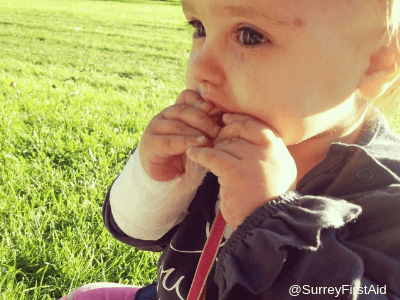-----------------------------------
A lady in a shop earlier today, in polite conversation, said: "Isn't it cold, I had to put my heating on this morning". At the time I didn't give it much thought, after months of warmth and sunshine I had forgotten my heating was on an automatic thermostat and when I got home all the radiators were blasting out heat.
I put my one-year-old down on the floor as I stepped in the house, like a moth to a lamp, she headed straight for the gurgling radiator and then screamed!
She was absolutely hysterical, waving her arms around. I couldn't see what was wrong but instantly picked her up and ran with her to the sink. As I splashed temped water over her arms I tried to work out which area of her skin had made contact. It became obvious when all her skin blistered and was then hanging off on her wrist. As a first aider, I know that burn needs cooling for at least 10 minutes and the importance of using cool but not cold water or ice.
What I wasn't prepared for was how hard it was to hold her whilst immersing her arms in the tepid water. She was wriggling and fighting to get free. The large blister which had formed very quickly popped straight away, leaving the burn to weep. I was on my own and my toddler was also trying to see what was happening, understandably asking questions and making it difficult to concentrate on the assessment needed.
Very quickly my little girl became quiet as she was going into shock. The burn did not appear to be hurting, which is often a common sign of a deep burn known as a full thickness burn, where the nerve endings are damaged. This type of burn used to be called a 1st-degree burn but nowadays we tend not to use this term and class burns as superficial burn, partial thickness burn or full thickness burn. Knowing that this was potentially a very serious burn I was very worried.
Now that she was calm, I used a burns gel followed by a loose non-adhesive dressing to try and keep the burn clean and prevent any infection
I knew from the depth and size this burn, that the burn would need to be dressed and assessed by a nurse. When I work in the control room for the ambulance service we do get calls on the 999 emergency line for burns like this, we advise that once the burn has been immersed in water and wrapped in the non-adhesive dressing, that you should go straight to the minor injuries unit or A&E at a local hospital (even if it stops hurting), especially as burns can take a while to appear, and in some cases, days for the depth of the burn to become apparent.
The whole experience was incredibly frightening and as with most common accidents in the home, could have been prevented by turning the radiators down or providing a guard for radiators which get particularly hot. Babies and young children's skin is particularly thin and sensitive and what may seem warm to us as adults can be hot for them.
Thankfully my little girl's arm is healing well now and she did not have to have a skin graft which the doctors thought was necessary at first.
Written by Tara Burn (Trainer at Surrey First Aid)




